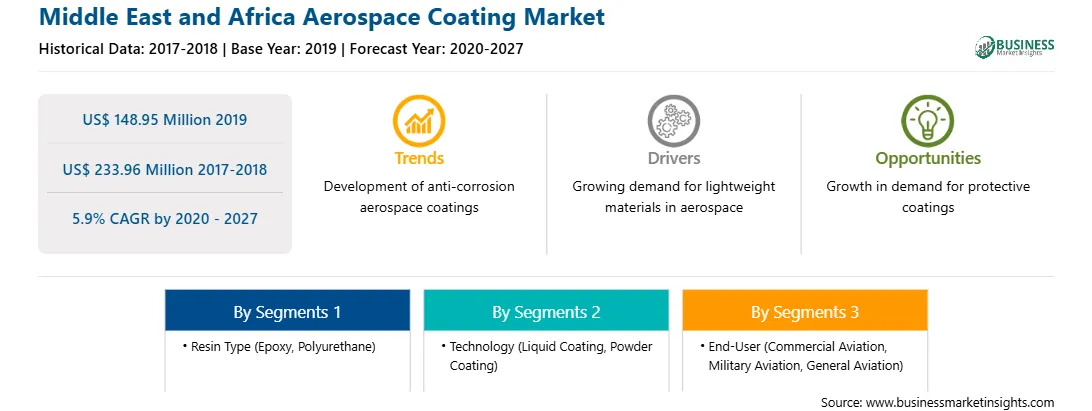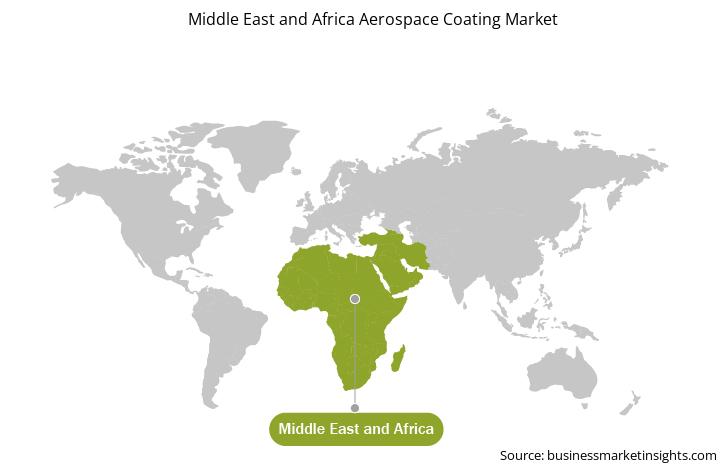Pages: 127
Aircrafts has to withstand high climatic stress which generally damages the metal surface resulting in frequent repairs and maintenance. Aerospace coatings provides high resistance against corrosion, ultraviolet rays and solar hear, fog and other adverse weather conditions. Aerospace coating not only provides protection the aircraft but also reduces the weight of the aircraft which helps in reducing CO2 emission. The requirement of coatings for aircraft is also due to the change in environment regulations. Aerospace coatings are designed in order to prevent temperature fluctuations, variable air pressure and variable air instabilities. Miniaturization, Precision and high strength has become the important features of aerospace coating.
The Middle East and Africa Aerospace Coating market was valued at US$ 148.95 million in 2019 and is projected to reach US$ 233.96 million by 2027; it is expected to grow at a CAGR of 5.9% during the forecast period 2020-2027. The growing environmental concerns across the world has made the manufacturers focus on bio-based epoxy resins. The aerospace industry uses epoxy coatings primers for floor coatings, corrosion protection, aerospace hangars, and corporate aircraft hangars, etc.
By resin type, the Epoxy segment accounted for the largest market share in the Middle East and Africa Aerospace Coating market in 2019. In terms of technology, the liquid coating segment held the largest market share of the Aerospace Coating market by 2019. In terms of end-user, the Military Aviation segment held the largest market share of the Aerospace Coating market by 2019.
Some of the major primary and secondary sources for Middle East and Africa Aerospace Coating market included in the report are Akzo Nobel N.V., BASF SE, Hardide plc., Henkel AG & Co. KGaA, Hentzen Coatings, IHI Ionbond AG, Mankiewicz Group, PPG Industries, Inc., The Sherwin-Williams Company, Zircotec.
South Africa has the largest COVID-19 cases in the Middle East and Africa region, and is followed by Saudi Arabia and UAE, among others. UAE was the first country in Middle East and Africa to report a confirmed case of coronavirus. Due to lockdown in Middle East and African countries, various chemicals and materials companies remain closed which led to the reduction in the sale of various products which has negatively impacted the market for Aerospace Coating in the region.
Strategic insights for the Middle East and Africa Aerospace Coating provides data-driven analysis of the industry landscape, including current trends, key players, and regional nuances. These insights offer actionable recommendations, enabling readers to differentiate themselves from competitors by identifying untapped segments or developing unique value propositions. Leveraging data analytics, these insights help industry players anticipate the market shifts, whether investors, manufacturers, or other stakeholders. A future-oriented perspective is essential, helping stakeholders anticipate market shifts and position themselves for long-term success in this dynamic region. Ultimately, effective strategic insights empower readers to make informed decisions that drive profitability and achieve their business objectives within the market.

| Report Attribute | Details |
|---|---|
| Market size in 2019 | US$ 148.95 Million |
| Market Size by 2027 | US$ 233.96 Million |
| Global CAGR (2020 - 2027) | 5.9% |
| Historical Data | 2017-2018 |
| Forecast period | 2020-2027 |
| Segments Covered |
By Resin Type
|
| Regions and Countries Covered | Middle East and Africa
|
| Market leaders and key company profiles |
The geographic scope of the Middle East and Africa Aerospace Coating refers to the specific areas in which a business operates and competes. Understanding local distinctions, such as diverse consumer preferences (e.g., demand for specific plug types or battery backup durations), varying economic conditions, and regulatory environments, is crucial for tailoring strategies to specific markets. Businesses can expand their reach by identifying underserved areas or adapting their offerings to meet local demands. A clear market focus allows for more effective resource allocation, targeted marketing campaigns, and better positioning against local competitors, ultimately driving growth in those targeted areas.

The Middle East and Africa Aerospace Coating Market is valued at US$ 148.95 Million in 2019, it is projected to reach US$ 233.96 Million by 2027.
As per our report Middle East and Africa Aerospace Coating Market, the market size is valued at US$ 148.95 Million in 2019, projecting it to reach US$ 233.96 Million by 2027. This translates to a CAGR of approximately 5.9% during the forecast period.
The Middle East and Africa Aerospace Coating Market report typically cover these key segments-
The historic period, base year, and forecast period can vary slightly depending on the specific market research report. However, for the Middle East and Africa Aerospace Coating Market report:
The Middle East and Africa Aerospace Coating Market is populated by several key players, each contributing to its growth and innovation. Some of the major players include:
The Middle East and Africa Aerospace Coating Market report is valuable for diverse stakeholders, including:
Essentially, anyone involved in or considering involvement in the Middle East and Africa Aerospace Coating Market value chain can benefit from the information contained in a comprehensive market report.